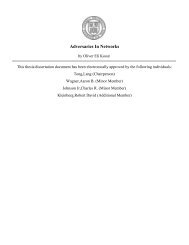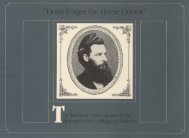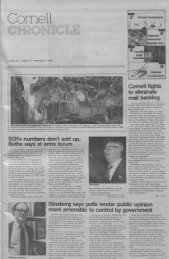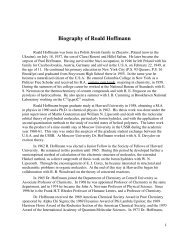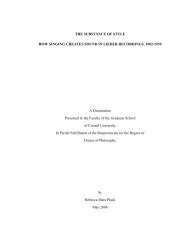Cornell Alumni News - eCommons@Cornell - Cornell University
Cornell Alumni News - eCommons@Cornell - Cornell University
Cornell Alumni News - eCommons@Cornell - Cornell University
Create successful ePaper yourself
Turn your PDF publications into a flip-book with our unique Google optimized e-Paper software.
BOOKLIST:<br />
• A selected list of books recently read<br />
by Professor Kenneth W. Evett, art, with<br />
notes and comments written for the John<br />
M. Olin Library Reader's Report:<br />
MR. CLEMENS AND MARK TWAIN!<br />
A BIOGRAPHY by Justin Kaplan. Simon &<br />
Schuster. 1966.<br />
In this fine book, biography and literary<br />
history are combined with unobtrusive but<br />
firm literary criticism. It covers the period<br />
in Mark Twain's life from the time he<br />
moved east in his thirties until his death,<br />
and it is a moving, revealing account.<br />
I wasn't aware that Clemens' life was<br />
significant of so many important aspects<br />
of American experience. He represents us<br />
with enough courage, frailty, foolishness,<br />
intelligence, and wit to make us both<br />
conscious of our limits and proud of our<br />
accomplishments. An insatiably curious<br />
wanderer, he went from Hannibal to Virginia<br />
City, San Francisco, Elmira, Buffalo,<br />
Hartford, New York, London, Heidelberg,<br />
and Florence and became the independent<br />
wide-ranging American. His nostalgia for<br />
lost innocence, his ambiguous attitude<br />
toward capital and labor, his ever-renewed<br />
faith in panaceas and get-rich-quick<br />
schemes, his love of status, his ambivalent<br />
attitudes toward European culture, are all<br />
familiar American concerns. However, the<br />
paradoxical dualities of his life—his two<br />
names, his public piety and private bitter<br />
disbelief, his tamed family morality and<br />
rutty bawdiness, his role as national jester<br />
and lonely bereaved parent are his own.<br />
Of all his talents, the one most mysterious<br />
and heart-warming is his humor. That<br />
sovereign power to transform the pitiful<br />
and absurd realities of life into a comic<br />
dimension is surely his true Promethean<br />
gift.<br />
SAINT JAMES IN SPAIN by T. D. Kendrick.<br />
Methuen. 1960.<br />
The landscape of Spain is so potent—<br />
bare, dry, harsh, rosy, golden, pink, and<br />
Evett<br />
olive green—the place names so evocative,<br />
Spanish painting so powerful, the space<br />
there so grand, the sky so luminous, and<br />
the people so grotesque or beautiful, that<br />
any book having to do with that country<br />
arouses my interest.<br />
This witty account of the legend of<br />
Saint James in Spain has all the fascination<br />
of a good British mystery. Kendrick<br />
describes the four basic tenets of the Santiago<br />
Creed and then proceeds to test their<br />
credibility in the light of historic research.<br />
Along the way he investigates such curious<br />
phenomena as the lead books of Granada,<br />
the Marian war in Seville, and the false<br />
chronicles of Dextro and Maximo, all<br />
the while keeping an eye on the Vatican<br />
and assessing its role in the various controversies<br />
associated with the Saint James<br />
legend.<br />
Whether this is good historical writing,<br />
I don't know, but it is certainly entertaining<br />
and it recounts one of the great mythic<br />
inventions of the West against the background<br />
of Galicia, Leon, Castile, Aragon,<br />
Andalusia and La Mancha—the dirty, incomparable<br />
land of Spain.<br />
CAN YOU FORGIVE HER by Anthony<br />
Trollope. Oxford. 1938.<br />
The fictional beings invented by Trollope<br />
in those pre-dawn writing sessions of<br />
his long productive life have for me a<br />
sturdy resistant reality. His ample imaginary<br />
world is occupied by all kinds of<br />
memorable persons who carry on their<br />
struggles within the firm limits of Victorian<br />
morality and caste. The tension between<br />
his characters and this clearly defined<br />
English social structure is the vital<br />
spark of Trollope's novels.<br />
In Can You Forgive Her, as in most<br />
of his work, the author carries on several<br />
plot strands at once. More or less improvising<br />
as he goes, sometimes lecturing the<br />
reader or commenting directly on his characters'<br />
good and bad points, sometimes<br />
wandering off to describe some favorite<br />
hobby (fox hunting) or phobia (British<br />
politics), Trollope generally rolls along<br />
at a good steady gait, his writing sustained<br />
throughout by an astringent but<br />
tolerant sense of humor.<br />
This volume hinges on the self-induced<br />
dilemma of a beautiful and spirited girl<br />
who suffers from moral pride to the point<br />
of folly. Her painful education in selfknowledge<br />
and humility is the major subject<br />
of the book. A sub-theme (the beginning<br />
of the Parliamentary novels) has<br />
to do with Plantagenet Palliser and his<br />
wife, Lady Glencora. We also meet a realistic<br />
but affectionate widow, some low<br />
political types, a manure-proud farmer,<br />
and other vigorous personalities.<br />
Can You Forgive Her may not have a<br />
diamond-hard formal structure and it may<br />
not plumb the very depths of the author's<br />
psyche (after all, he was a respectable<br />
Victorian postal clerk) but it does have<br />
the breath of life.<br />
REDEMPTION OF THE ROBOT by Herbert<br />
Read. New York. Trident. 1966.<br />
Sir Herbert Read makes the un-American<br />
suggestion that the way toward the<br />
moral regeneration of the human race<br />
and universal peace is through an educational<br />
process based on art. Initially<br />
such an implausible notion hardly seems<br />
interesting, and the early parts of the book<br />
drag along under a burden of the reader's<br />
incredulity. However, patiently building<br />
up his argument, quoting from numerous<br />
sources—Plato, Rousseau, Freud, Schiller<br />
Pestalozzi, Gropius, to name a few—Read<br />
finally commands attention to his views.<br />
He believes that children should be educated<br />
in "reference to things." Learning<br />
to organize things in patterns of harmony<br />
and proportion according to inherent aesthetic<br />
need gives the child pleasure. Associating<br />
the creation of order with pleasure,<br />
the child begins to develop an inner<br />
discipline in which the organization of experience<br />
through art activity—dance, music,<br />
and the visual arts—eventually leads<br />
to a moral judgment based on the awareness<br />
that positive, form-controlling acts<br />
are good.<br />
The ordering patterns of children are<br />
archetypal and universal. When they sink<br />
into the subconscious, they not only constitute<br />
a bond with all other children but<br />
determine further patterns of response.<br />
An education based on the constantly renewing<br />
process of free aesthetic choices<br />
would help to save society from the degrading<br />
effects of automation and destructive<br />
aggressions. Read identifies the<br />
creation of orderly patterns as life-affirming<br />
and loving as opposed to equally




